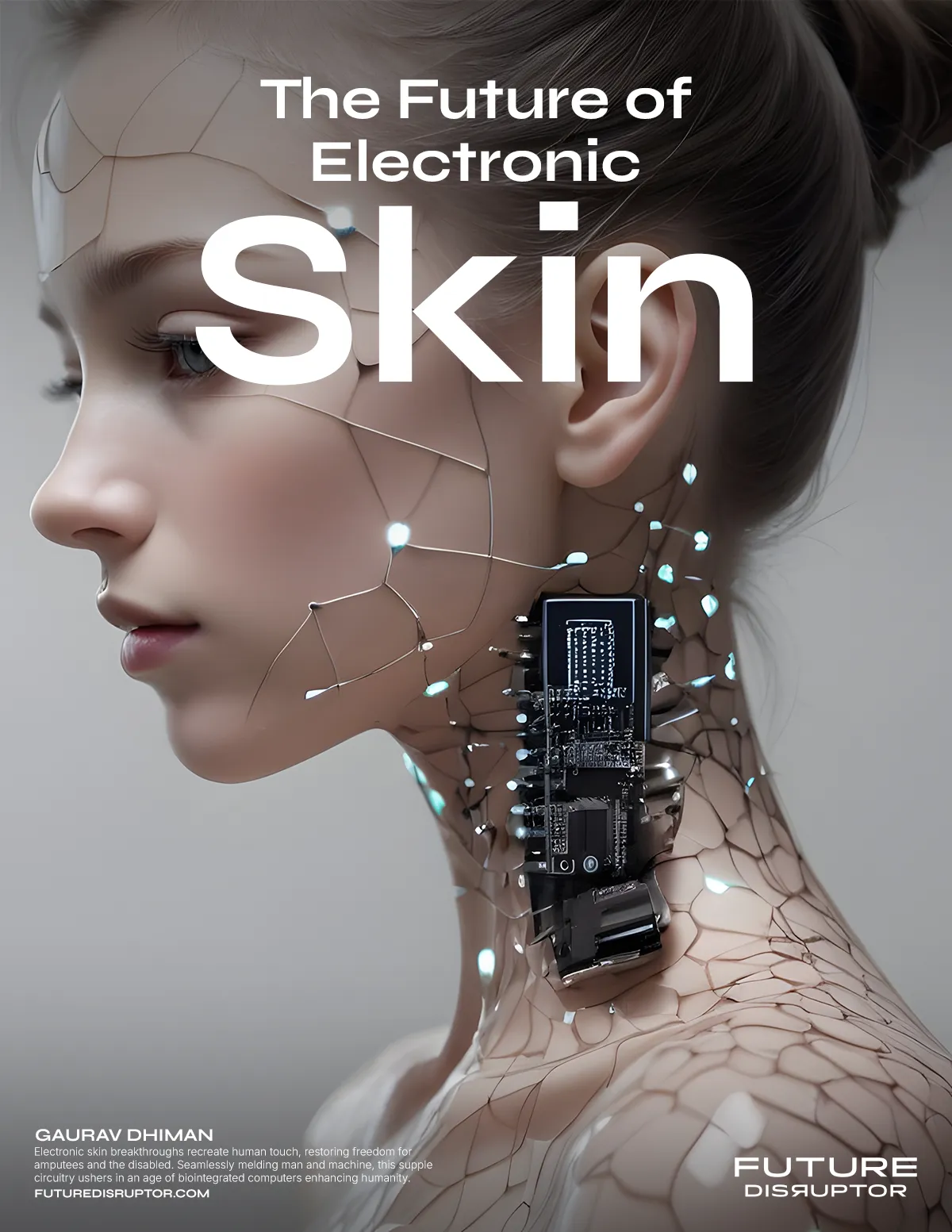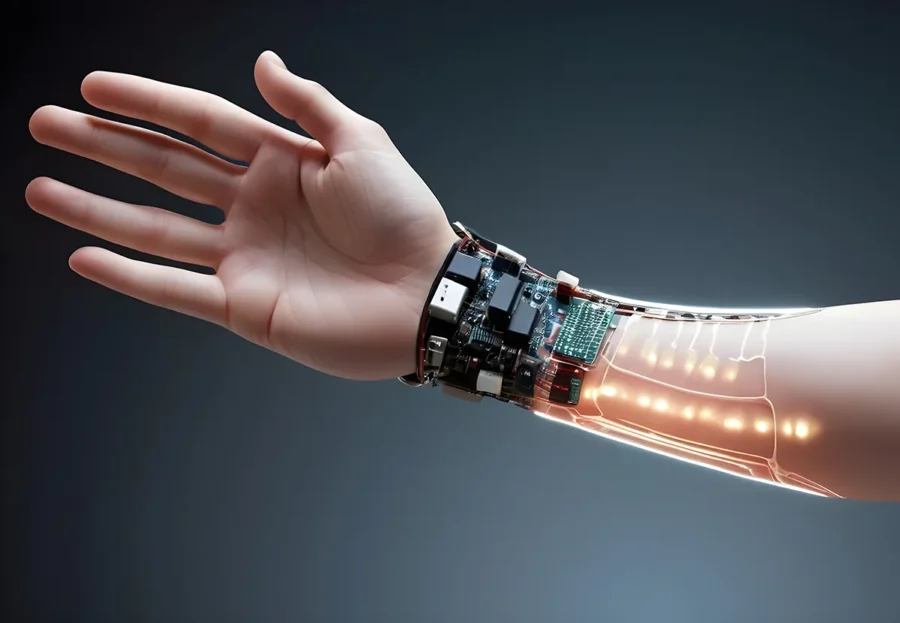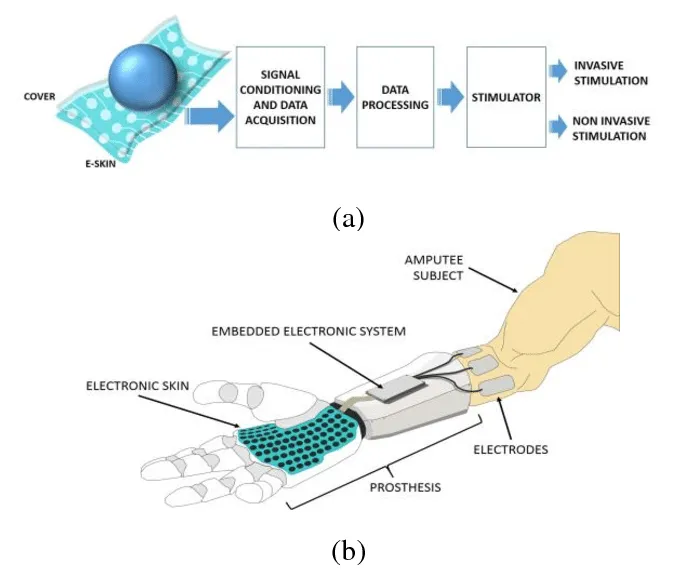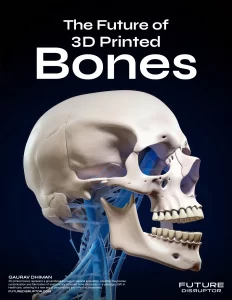The Future of Electronic Skin (E-Skin)

Electronic skin, or e-skin, is a type of artificial skin that can mimic the sensing abilities of human skin, such as detecting changes in heat, pressure, and touch.
E-skin is made of flexible, stretchable, and self-healing materials that can be attached to the skin’s surface or integrated into wearable devices, robots, prosthetics, and health monitors.
E-skin has many potential applications in robotics, artificial intelligence, prosthetics, and health monitoring.
It is also known as or related to artificial skin, epidermal electronics, biomimetic sensors, and conformable electronics.
Practical Applications
Here are some of the practical applications of electronic skin:
Enhanced Healthcare
- Real-time health monitoring: Its sensors can continuously track vital signs like heart rate, blood pressure, and even glucose levels, enabling proactive health management and early disease detection.
- Personalized medicine: Gather in-depth physiological data to inform personalized treatment plans and medication dosages, tailoring healthcare to individual needs.
- Improved prosthetics: Equip prosthetic limbs with sensory feedback, allowing users to experience touch, temperature, and pressure, mimicking natural sensations and enhancing quality of life.
- Remote patient monitoring: Its patches can remotely monitor patients with chronic conditions, reducing hospital visits and improving healthcare accessibility.
Advanced Human-Machine Interface
- Intuitive control: Integrate into clothing or devices to facilitate natural gesture-based control of electronics, simplifying user interactions and creating seamless interfaces.
- Augmented reality (AR) applications: They can provide real-time feedback to users in AR environments, blurring the lines between the physical and digital worlds and enhancing experiences.
- Virtual reality (VR) immersion: Offer sensory feedback in VR settings, making virtual interactions more realistic and immersive, from feeling virtual objects to experiencing simulated environments.
Enhanced Safety and Security
- Biometric identification: Its sensors can offer highly secure and personalized biometric identification based on unique physiological signatures, surpassing traditional fingerprint or facial recognition.
- Environmental monitoring: E-skin sensors integrated into buildings or infrastructure can detect various environmental changes, from temperature and humidity to air quality and potential hazards, ensuring safety and comfort.
- Military and disaster response: Equip soldiers and first responders with advanced sensing capabilities for enhanced situational awareness, communication, and safety in challenging environments.
Beyond these, e-skin also holds the potential for:
- Personal fitness tracking and coaching: Provide personalized feedback on movement, posture, and exercise performance.
- Neurological applications: Assist in diagnosing and treating neurological disorders by monitoring brain activity through the skin.
- Gaming and entertainment: Create immersive experiences with real-time physical feedback in games and virtual environments.
Researchers are exploring new materials, structures, and mechanisms to make e-skin more flexible, stretchable, multifunctional, and large-area. This technology is expected to significantly impact various areas of science, engineering, medicine, and society in the near future.

How Does It Work?
The basic steps of how e-skin technology works are:
- Design flexible and stretchable materials that can conform to various shapes and surfaces, such as polymers, carbon-based molecules, or hybrid materials.
- Incorporate sensors and circuits that detect and transmit signals like temperature, pressure, touch, and other stimuli.
- Integrate power sources and wireless communication modules that transmit energy and data for the e-skin devices.
- Develop self-healing mechanisms to repair the e-skin devices when damaged or worn out.
Evolve in the Future
In relation to other future trends and technologies mentioned on Future Disruptor, these are the ways we envision how e-skin technology can evolve in the future:
- Develop e-skin that can self-heal from damage using polymer-based materials or hybrid materials that can reform covalent bonds or non-covalent crosslinks.
- Improve the flexibility, stretchability, and robustness of e-skin through nanowire transistors and pressure sensors on a sticky plastic film.
- Enhance the sensing functions of e-skin by incorporating organic light-emitting diodes, transistors, and photovoltaic cells for displays, lighting, and energy harvesting.
- Integrate e-skin with other devices like wireless, Bluetooth-connected polymers and circuitry to monitor human vital signs, speech, and coughing rates.
Help Organizations/Enterprises
Electronic skin technology can help organizations and enterprises in various ways, including:
- Health monitoring: It can monitor vital signs, hydration, temperature, blood pressure, and other health parameters of employees, customers, or patients. For example, e-skin devices can be worn by health workers to detect early signs of COVID-19 or by athletes to optimize their performance.
- Prosthetics: It can provide a realistic and functional interface for prosthetic limbs, allowing amputees to regain the sense of touch and control their movements. For example, e-skin can be integrated with artificial muscles and nerves to create biohybrid limbs.
- Robotics: It can enhance the interaction and communication between robots and humans and between robots and their environment. For example, e-skin can enable robots to feel pressure, temperature, texture, and shape and to adjust their actions accordingly.
- Virtual reality: It can create a more immersive and realistic virtual reality experience by adding the sense of smell and touch. For example, e-skin can stimulate the olfactory and tactile receptors of the user and synchronize them with the visual and auditory stimuli.
Driving Adoption
Some of the factors that are driving the adoption of e-skin are:
- There is increasing demand for wearable devices to monitor vital signs, physiological parameters, and biomarkers in real time.
- The advancement of 3D printing, flexible circuits, self-healing materials, and wireless sensing technologies enable the fabrication of e-skin devices with high performance, durability, and biocompatibility.
- The growing interest in human-machine interaction, especially in robotics and prosthetics, requires e-skin devices to provide realistic and responsive tactile feedback.
Operational Challenges
E-skin faces several challenges in its development and deployment, including:
- Integration: It needs to be compatible with the human body and the environment, which requires careful design of the materials, structures, and interfaces of the sensors and circuits.
- Data processing: It generates large amounts of tactile data that need to be processed efficiently and effectively, which requires novel algorithms and architectures for information extraction, compression, and transmission.
- Regulation: Its applications in medicine and health care must comply with strict regulatory norms and ethical standards, which may limit the scope and speed of innovation and adoption.
- Cost: It involves complex fabrication and integration processes that may increase the cost and reduce the scalability of the technology, which may hinder its accessibility and affordability.
These challenges require interdisciplinary collaboration and innovation among researchers, engineers, clinicians, and policymakers to overcome them and realize the full potential of e-skin technology.
Success Stories
Some of the success stories of electronic skin are:
- A team at Stanford University developed a soft integrated circuit that can generate nerve-like impulses that talk to the brain, which could enable amputees to control prosthetic limbs with sensory feedback.
- A University of Colorado Boulder team created a self-healing, recyclable e-skin that can sense touch, temperature, humidity, and airflow, which could be used for environmental sensing and interactive devices.
- A Graz University of Technology team achieved a breakthrough with a hybrid smart skin material that can sense temperature, moisture, and pressure, which could be used for next-generation artificial skin.
- A team at the University of Tokyo developed a thin, light, and flexible e-skin that can display simple animations based on changes in body temperature, which could be used for wearable art and fashion.

Types
There are different electronic skins, depending on the materials, sensors, and functions they use. Some of the common types are:
- Piezoresistive e-skin: It changes its electrical resistance when deformed by pressure or strain. It can measure mechanical stimuli such as touch, force, and vibration.
- Capacitive e-skin: It stores electric charge when compressed or stretched. It can sense changes in pressure, humidity, and temperature.
- Piezoelectric e-skin: It generates an electric voltage when bent or twisted. It can convert mechanical energy into electrical signals and vice versa. It can be used for tactile feedback, energy harvesting, and acoustic sensing.
- Transistor-type e-skin: It can control the flow of electric current by applying a voltage. It can integrate multiple sensors and circuits on a single platform and achieve high sensitivity and resolution. It can also perform signal processing and data transmission.
Advantages
E-skin technology has many advantages, such as:
- Helping the body to adjust after a transplant.
- Making robots more sensitive and responsive.
- Generating impulses similar to that of the body’s nervous system.
- Leading to advancements in medical equipment, such as wearable devices for health monitoring.
- Withstanding mechanical deformation, such as stretching and flexing, without losing functionality.
- It is used in prosthetics, artificial intelligence, soft robotics, biocompatibility, and communication devices.
- It is a non-invasive, comfortable, and painless way to monitor vital signs and health data, eliminating the need for traditional medical devices that can be cumbersome and require invasive procedures.
Disadvantages
Electronic skin faces some challenges and disadvantages, such as:
- Cost: It is not readily available and could be extremely expensive to produce and maintain. The materials, fabrication, and integration of e-skin devices require high-quality standards and advanced techniques.
- Durability: Associated devices are often fragile and prone to damage from mechanical strain, environmental factors, or wear and tear. They may require frequent repair or replacement, affecting their functionality and reliability.
- Safety: These devices may pose health risks to the users or the environment if they contain toxic or hazardous substances, such as metals, organic solvents, or nanomaterials. They may also cause allergic reactions, infections, or inflammation if they are in contact with the skin or implanted in the body.
- Ethics: May raise ethical and social issues, such as privacy, security, identity, and human dignity. For example, e-skin devices may collect and transmit sensitive personal data, such as biometric information, without the user’s consent or awareness. They may also alter the user’s perception of reality, self, and others, creating a sense of detachment or alienation.
Ethical Concerns
Here are the ethical concerns associated with e-skin technology:
- The possible misuse or abuse of e-skin devices by hackers, criminals, or malicious actors who could access, manipulate, or damage the devices or the data.
- The social and psychological implications of e-skin devices include how they affect human identity, self-image, autonomy, dignity, and social interactions.
- The moral and legal responsibility of e-skin users, developers, manufacturers, and regulators, such as who is liable for the harms or benefits caused by e-skin devices and how to ensure the safety, quality, and ethics of e-skin products.
- The privacy and security of the data collected by e-skin devices, especially when connected to the Internet or other networks.
Governance and Regulation
Governance and regulation of electronic skin technology is a complex and important issue that requires researchers, engineers, clinicians, policymakers, and people to come together to work on these key aspects:
- Ethics: It raises ethical questions about the privacy, security, consent, and ownership of the data collected and transmitted by the devices, as well as the potential social and psychological impacts of the technology on the users and society.
- Standards: It needs to meet certain standards of quality, safety, performance, and reliability, which may vary depending on the application and the context. Standards also need to be harmonized across different regions and countries to facilitate the global development and deployment of the technology.
- Innovation: Continuous innovation and improvement are required to address the technical challenges and the changing needs and expectations of the users and the market. Innovation must also be supported by adequate funding, infrastructure, and education.
There is no one-size-fits-all solution for the governance and regulation of e-skin, as it depends on each device and application’s specific characteristics and implications. Therefore, a multidisciplinary and participatory approach is needed to ensure the technology is developed and used responsibly and beneficially for society.
History
Electronic skin technology has a long development history, starting from the early attempts to measure the electrical activity of the brain and the heart using electrodes attached to the skin. Some of the key milestones are:
- In 1929, Hans Berger invented the electroencephalograph (EEG), which attaches to the scalp and measures the brain’s electrical activity.
- In 1949, John Hopps developed the first cardiac pacemaker, which uses electrical impulses to regulate the heartbeat.
- In the 1960s, researchers began to explore using flexible and organic materials for electronic devices, such as light-emitting diodes (LEDs), transistors, and solar cells.
- In the 1980s, scientists developed the first flexible sensor arrays inspired by human skin to detect touch, pressure, and temperature.
- In the 1990s, researchers integrated flexible sensors with microelectronics and wireless communication, creating the first wearable and implantable e-skin devices for health monitoring and prosthetics.
- In the 2000s, researchers improved the performance, durability, and biocompatibility of e-skin devices and introduced new functionalities such as self-healing, recyclability, and color-changing.
- In the 2010s, researchers demonstrated using e-skin devices in various applications, such as robotics, artificial intelligence, and interactive art.
E-skin technology is still evolving and expanding as researchers continue to find new ways to mimic and enhance the capabilities of human skin.
Tools and Services
Different kinds of elements make electronic skin work:
- A wearable sensor can track vital signs such as heartbeat, breathing, and coughing rates and transmit the data wirelessly to a smartphone or laptop.
- A flexible circuit printed onto the skin can measure temperature, strain, and hydration levels and work even when stretched.
- A self-healing e-skin that can repair itself from damage and restore its functionality.
- A prosthetic hand that can sense touch, pressure, and temperature and send electrical signals to the brain.
- An LED display can be worn on the back of the hand to show health data or other information.
- A soft robot that can adapt to its environment and manipulate objects with a gentle touch.

How to Get Started?
To start developing and working with e-skin technology, you can:
- Learn the basics of organic electronics, flexible and stretchable materials, sensors and circuits, and bioelectronics. These resources are in the Learn More section below, including books, articles, and online courses.
- Follow the latest research and developments in e-skin technology. You can read scientific journals, magazines, and blogs that cover e-skin and related fields.
- Join a community of e-skin enthusiasts and experts. You can participate in online forums, webinars, workshops, and conferences on e-skin technology. You can also network with researchers, engineers, and innovators on e-skin projects.
- Experiment with e-skin devices and applications. You can build your e-skin prototypes using available materials, tools, and kits. You can also explore the potential uses and benefits of e-skin technology in various domains, such as robotics, prosthetics, artificial intelligence, and health monitoring.
Best Practices
To get the most from this technology, some of the best practices are:
- Choose the right materials and fabrication methods: E-skin devices should be made of materials that are flexible, biocompatible, durable, and conductive. They should also be fabricated using scalable, cost-effective, and precise techniques.
- Optimize the data acquisition and transmission: E-skin devices should be able to collect and transmit sensory data in real-time, with high accuracy and resolution. They should also be integrated with wireless communication and data processing technologies like Bluetooth, IoT, and artificial intelligence.
- Ensure the safety and ethics of the users and the environment: E-skin devices should be tested and certified for their safety and performance and comply with medical and environmental regulations. They should also respect the privacy, security, identity, and dignity of the users and society.
Related Terms
You will often come across these relevant terms, so we have added them here for your ease:
- Flexible electronics: A type of electronics that can bend, fold, stretch, or conform to different shapes without losing functionality.
- Tactile sensing: A type of sensing technique that can detect and measure physical contact, such as pressure, force, vibration, and texture.
- Self-healing materials: A type of materials that can repair themselves when damaged by external stimuli, such as heat, light, or chemicals.
- Bioelectronics: A field of science and engineering that combines electronics with biology, such as using electronic devices to interface with living tissues, cells, or molecules.
- Human-machine interaction: A field of study and practice that explores how humans and machines communicate, cooperate, and collaborate.
Learn more
Research Papers
- Electronic skin: from flexibility to a sense of touch by Katharine Sanderson: Provides an overview of the current state and prospects of e-skin technology, focusing on the flexible and stretchable materials and devices that enable health monitoring, prosthetics, and robotics applications.
- E-Skin: The Dawn of a New Era of On-Body Monitoring Systems by Alina-Cristina Bunea, Violeta Dediu, Edwin Alexandru Laszlo, Florian Pistriţu, Mihaela Carp, Florina Silvia Iliescu, Octavian Narcis Ionescu, and Ciprian Iliescu: Reviews the recent trends in developing e-skin systems for monitoring human physiological signals, such as temperature, pulse, and bio-electric signals. It also discusses The fabrication techniques of E-skin systems, power supply, and signal processing.
- Advances in electronic skin research: a bibliometric analysis by Shiyong Xu, Xiaona Yu, Jie Chen, and Yuan Jing: Analyzes the bibliometric data of e-skin research from 2000 to 2020, using various indicators such as productive countries/regions, institutions, journals, citations, highly cited papers, keywords, and emerging topics. It also identifies the research hotspots and frontiers of e-skin.
- Tracing the Evolving Trends in Electronic Skin (e-Skin) Technology Using Growth Curve and Technology Position Based Patent Bibliometrics by Janghyeok Yoon, Byeongki Jeong, Wi Hyoung Lee, and Jonghwa Kim: This research uses patent-based bibliometric analyses to study the evolving characteristics of e-skin technology in terms of the technology life cycle and the technology position. It also provides insights into the technological development and innovation of e-skin.
- Sensors for Biosignal/Health Monitoring in Electronic Skin by Hyeon Seok Oh, Chung Hyeon Lee, Na Kyoung Kim, Taechang An, and Geon Hwee Kim: Reviews the basic technologies of e-skin devices for biosignal and health monitoring, such as sensing mechanisms and materials. It also discusses the challenges and prospects of e-skin technology.
Articles
- A review of electronic skin: soft electronics and sensors for human health by Songyue Zhang, Shunbo Li, Zengzilu Xia, and Kaiyong Cai: This article from Journal of Materials Chemistry B reviews several categories of e-skin for monitoring signals involved in human health. Reviews several categories of e-skin for monitoring signals involved in human health, such as pressure, strain, temperature, humidity, and electrophysiological signals. It also covers E-skin’s advanced candidate materials, compositions, structures, and integration strategies, focusing on stretchable and wearable electronics.
- Soft ‘electronic skin’ mimics our sense of touch: This article from Nature reports on a recent breakthrough in e-skin development that can mimic the same process that causes a finger, toe, or limb to move when poked or scalded. The technology could lead to the development of a covering for prosthetic limbs that would give their wearers a sense of touch or help restore sensation in people whose skin has been damaged.
Books
- Electronic Skin: Sensors and Systems by Ali Ibrahim and Maurizio Valle: Focuses on the main components of the e-skin system, such as sensing materials, front-end electronics, embedded processing, and communication interfaces. It also discusses the relevant applications of e-skin technology in various domains, such as robotics, prosthetics, artificial intelligence, and health monitoring.
Others
- Fully integrated pressure-controlled electrochromic E-skins: Introduces a pressure-controlled electrochromic device that integrates pressure-sensing and color-changing functions in a vertical assembly. It shows how this device can create a multi-pixel matrix E-skin system to indicate the pressure exertion point by color variation.
- Electronic Skin by Prof. Ravinder Dahiya: This is a seminar that covers the recent advances in e-skin technology, such as flexible and stretchable electronics, self-healing materials, and bioelectronics. It also discusses the future challenges and opportunities of e-skin in human-machine interaction, smart cities, and mobile health.
- Webinar on Flexible Electronic Skin by Proceedings of the IEEE: This webinar provides an overview of various sub-topics of e-skin discussed in the October 2019 Proceedings special issues, such as tactile sensing, 3D printing, wireless communication, and ethical issues.
I hope you enjoyed this insightful discourse. I believe that open dialogue and diverse perspectives are essential for fostering a deeper understanding of complex issues. Therefore, encourage you to share your thoughts and opinions in the comments below. Engage with other readers, challenge assumptions, and contribute to a rich and meaningful discussion. Your insights are valuable, and welcome you to participate actively in this intellectual exchange.
Together, we can explore new ideas, expand our horizons, and generate fresh perspectives.

Learner-in-Chief at Future Disruptor. A futurist, entrepreneur, and management consultant, who is passionate about learning, researching, experimenting, and building solutions through ideas and technologies that will shape our future.
Subscribe to the Future Disruptor newsletter.






Leave a Reply